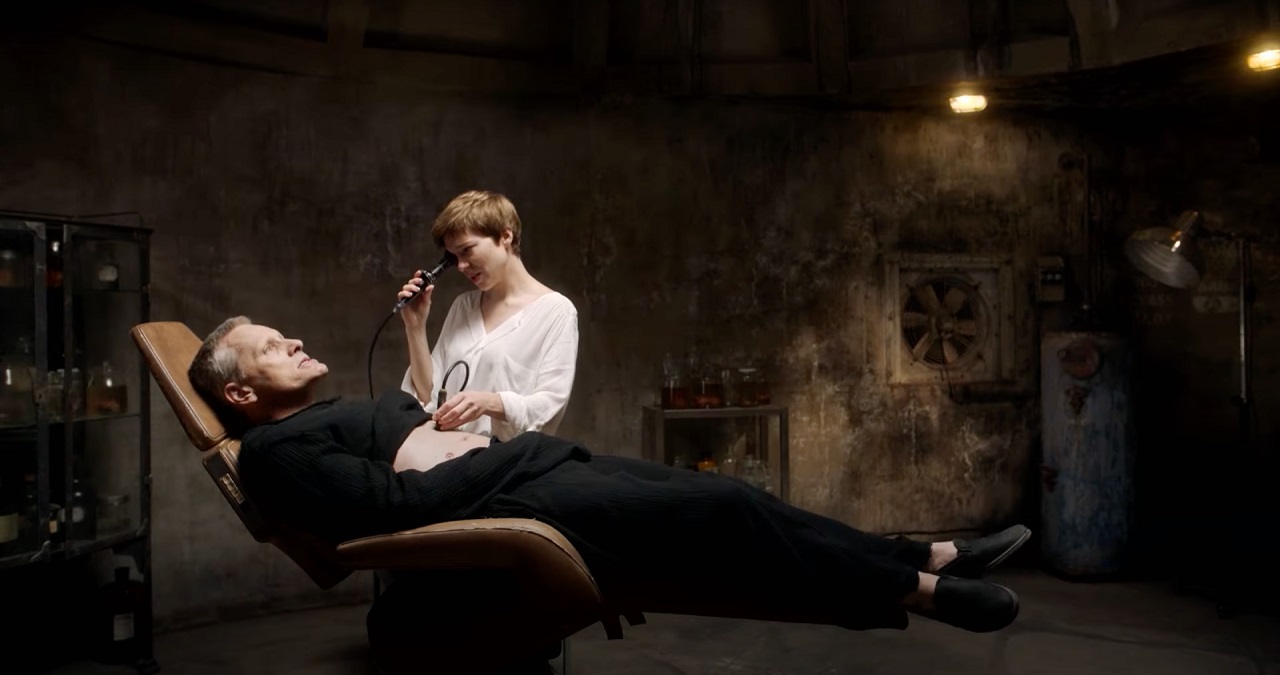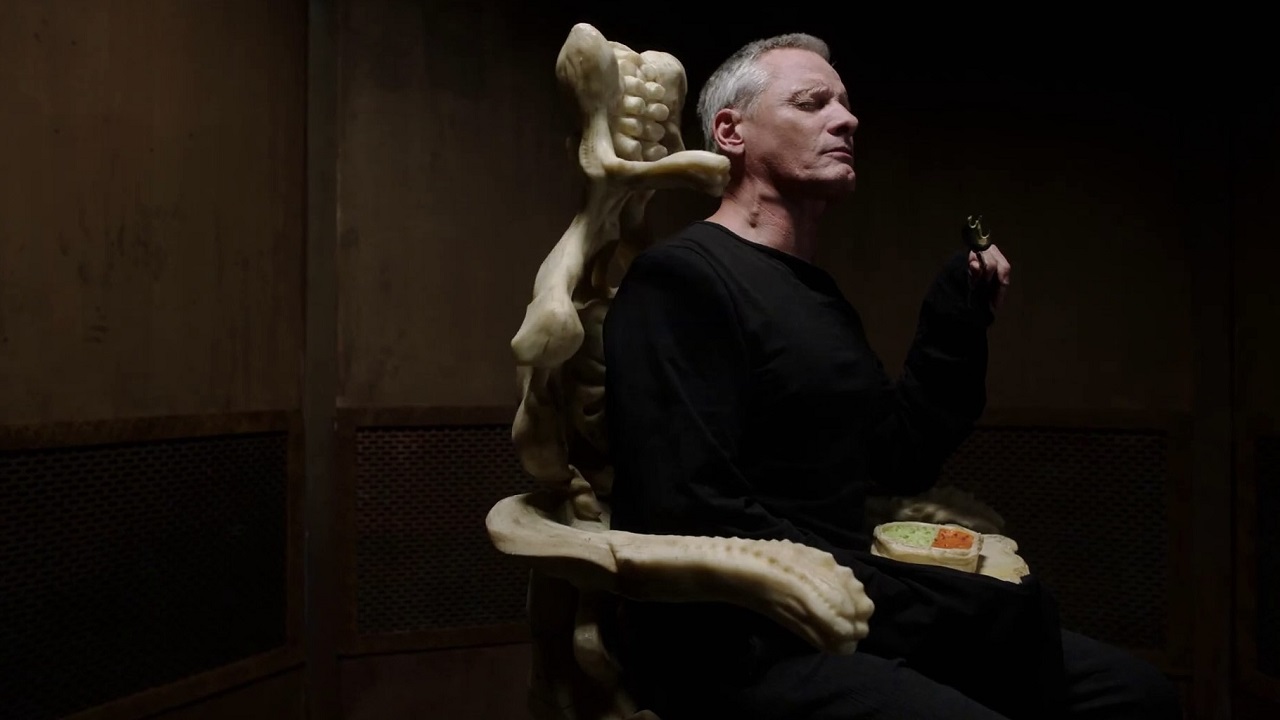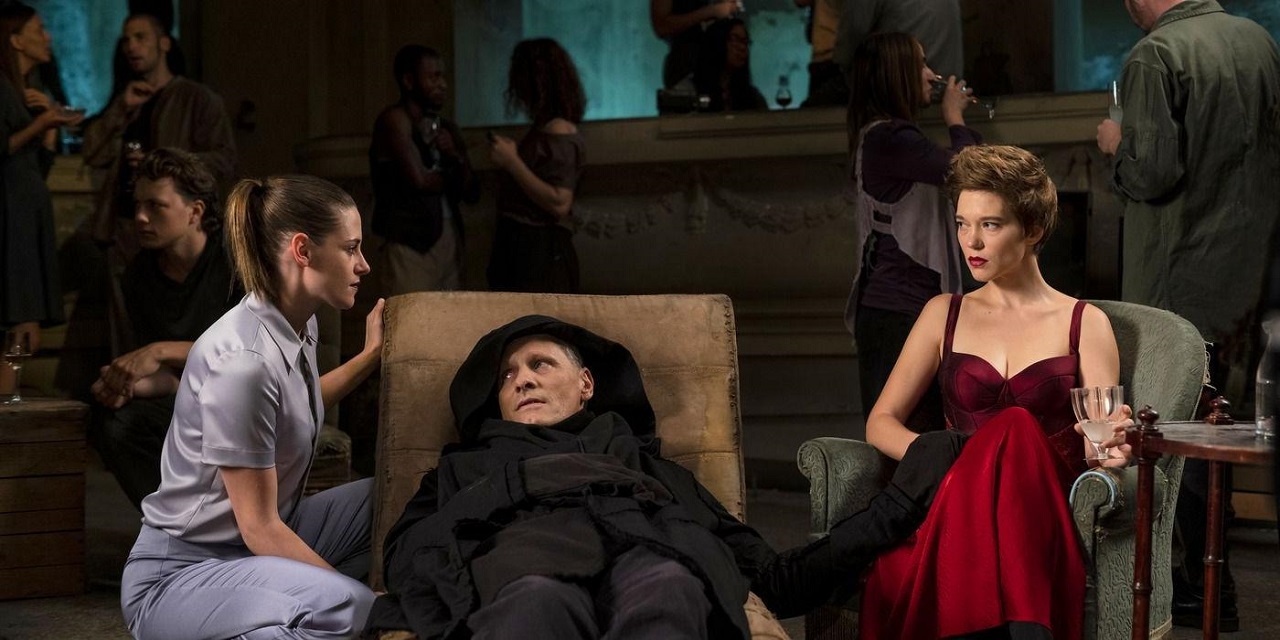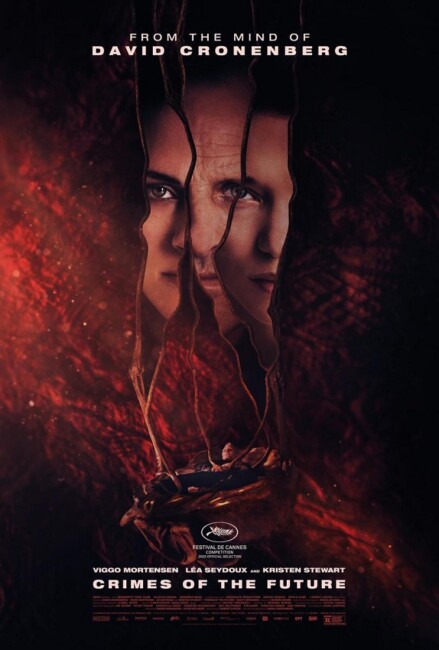Canada/Hellenic Republic [Greece]. 2022.
Crew
Director/Screenplay – David Cronenberg, Producers – Robert Lantos, Panos Papahadzis & Steve Solomos, Photography – Douglas Koch, Music – Howard Shore, Visual Effects – Rocket Science VFX (Supervisor – Peter McAuley), Makeup Design – Evi Zafiropoulou, Prosthetics – Alahouzos Studio FX (Supervisor – George Alahouzos), Black Spot FX (Designers – Alexandra Anger & Monica Pavez) & Walter Klassen FX, Production Design – Carol Spier. Production Company – Neon/Serendipity Point Films/Telefilm Canada/Ingenious Media/Argonauts Productions S.A./Crave/CBC Films/ERT/Rocket Science/Ekome/Greek Film Center/Ontario Creates.
Cast
Viggo Mortensen (Saul Tenser), Lea Seydoux (Caprice), Don McKellar (Wippett), Kristen Stewart (Timlin), Scott Speedman (Lang Dotrice), Welket Bungue (Detective Cope), Nadia Litz (Router), Tanaya Beatty (Berst), Sotiris Siozos (Brecken Dotrice), Lihi Kornowski (Djuna Dotrice), Efi Kantza (Adrienne Berceau), Yorgos Pirpassopoulos (Dr Nasatir), Denise Capezza (Odile)
Plot
In the future, surgery has become commonplace to the point that anybody can perform it. Saul Tenser and Caprice are surgical performance artists – he produces new organs from his body and she removes them before live audiences. Saul begins to investigate an underground movement of radical evolutionists at the same time as a police detective begins to probe around. They are now approached by Lang Dotrice, who suggests that they conduct an autopsy on his son Djuna as part of their performance. Saul becomes fascinated after learning that Djuna was murdered by Dotrice’s ex-wife because he had developed an ability to eat and digest plastic.
Canada’s David Cronenberg is an internationally celebrated director. Cronenberg started out making very abstract experimental films with the likes of Stereo (1969) and the original Crimes of the Future (1970). He soon found a welcoming home and more commercial success in the horror genre with works such as Shivers/They Came from Within (1975), Rabid (1976), The Brood (1979), Scanners (1981), Videodrome (1983), The Dead Zone (1983) and The Fly (1986), while still retaining a unique individualistic voice.
From about Dead Ringers (1988) onwards, Cronenberg began to leave easy genre confines behind and made a series of works pitched to the artistic mainstream with the likes of M. Butterfly (1993), Spider (2002), A History of Violence (2005), Eastern Promises (2007), A Dangerous Method (2011), Cosmopolis (2012) and Maps to the Stars (2014). Certainly, during this time he made adaptations of controversial literary works with Naked Lunch (1991) and Crash (1996) but the bulk of his output has trodden a more mainstream line. This period has seen the occasional venture back into genre material upon Cronenberg’s part with Naked Lunch, eXistenZ (1999) and Spider, while both Crash and Cosmopolis can be considered slipstream works. Indeed, this period has seen more remakes of Cronenberg’s films than actual full-blooded genre works – Rabid (2019) and the announced gender-flipped tv series remake of Dead Ringers (2023), while The Brood has been announced for a remake since the early 2000s and the early 1990s were inundated by a series of desultory Scanners sequels.
Aside from Stephen Knight’s original screenplay for Eastern Promises, Crimes of the Future is the first time that Cronenberg has made a film that hasn’t adapted from somebody else’s source work since existenZ – before that you would have to go all the way back nearly forty years to Videodrome in 1983 (even if some of his films, The Fly and Dead Ringers, vary so widely from the source that they could be considered original screenplays). Crimes to the Future is certainly a work that Cronenberg had been planning and several times announced for the better part of twenty years.
Cronenberg is just short of eighty years old – he turned 79 just before Crimes of the Future was released. Crimes of the Future is a brilliant work that I would sit up behind Dead Ringers as his second best film. If this were to be his swan song, it would be the perfect bookend to Cronenberg’s career. The film is Cronenberg returning to the vein of body horror films he essentially trademarked in the 1970s/80s, all elevated through the modern fascination with celebrity and body modification. About the one thing I was surprised he didn’t incorporate is the fascination with gender modification surgery that has taken off in recent years – although one suspects that Cronenberg could make an entire film all of its own out of that.

Crimes of the Future is a full renaissance of Cronenberg themes. There are the characters with bizarrely evocative names that sit on the tip of the tongue – Saul Tenser, Caprice, Lang Dotrice, Dani Router. There are all the provocative agitprop statements that you could easily imagine coming from a Professor Brian O’Blivion – “Surgery is the new sex,” “Body is reality.” There is theme that runs through almost every Cronenberg film from the 1970s and 80s, and others like Crash, of characters who regard mutation, infection and bodily mutilation as some form of catharsis leading to a process of psychological transformation. In particular, there is the erotic fetishisation with surgery that appears in Dead Ringers – Crimes of the Future also continues the joke from that film about having beauty pageants for the inner body.
There is some connection to Cronenberg’s earlier 1970 Crimes of the Future of the same title, which was set in a future where people are producing strange bodily mutations and a radical underground that were proposing experimentation using a child. That film had one humorous section about a character who would spontaneously produce new organs and then break into the store room to steal them back after they were removed. (You suspect that Crimes of the Future 1970 could actually act as a sequel to this film – we see people starting to produce bodily mutations and it wouldn’t be hard to see these extended to the production of Rogue’s Malady and the other infections we see in that film). In other interesting connections, Cronenberg’s son Brandon also directed Antiviral (2012) set in a future that has a not dissimilar scenario where people would infect themselves with viruses from celebrities. If you are looking for antecedents for Crimes of the Future, you could even point to the scene in Brüno (2009) where Sacha Baron Cohen holds a gameshow where people try to guess the identity of celebrity foetuses. Indeed, a few days after seeing Crimes of the Future, I also watched Peter Strickland’s Flux Gourmet (2022), which has many similarities in its idea of sonic catering as performance art that pushes many similar taboo boundaries.
Crimes of the Future immediately signals something different to the safety zone of Cronenberg’s films of the last two decades – from the moment we open on Howard Shore’s bold captivating score. (This is one of the few scores where I have immediately wanted to go and get a copy – indeed, is one of the few soundtracks in recent years that does more than blandly underscore the action in a film). This is a film that is constantly shooting out of our assumptions about what is going on. The opening shot is on a shoreline dominated by a strange alienating piece of architecture (which I was surprised to read it is actually a shipwreck in Attica, Greece). We are then introduced to mother Sotiris Siozos and son Lihi Kornowski and his retreating to his room where we see him chewing on the plastic trash bin, all before the mother comes in to place a pillow over his face and kill him.

In the next scene, Lea Seydoux enters a darkened room and opens the blinds. The otherwise empty room contains what looks like a strange sculpture that resembles a shell or insect carapace suspended between floor and ceiling attached to tubes, which turns out to be a bed that Viggo Mortensen sleeps inside. There’s the casual assumptions littered through their conversation “I think this bed needs new software – it’s not anticipating my pain anymore.” We then see Lea internally probing Viggo’s stomach with a device like a stethoscope that she looks through, while they get excited about him producing a new organ. In the next scene, we see Viggo upright in a skeletal chair – one that resembles a full size version of the gynaecological instruments for mutant women from Dead Ringers – that rocks about as its claws enclose him, while he struggles to raise a spoon to eat something.
There is a strong sense of being in a Future Setting where all contemporary references have been overturned. This continues in the scenes where Viggo Mortensen and Lea Seydoux visit the offices of the National Organ Registry, which is hinted as being a shady, disreputable organisation. Don McKellar has a speech where he talks about how governments are trying to police the fact that new organs are eroding what can be classified as human any longer. He also decries the fact that people no longer feel pain except in their sleep or have worries about infection, and the prevalence of Desktop Surgery that everybody can perform – we later see someone operating on a woman’s leg in an alleyway. This comes amid lines like “Our records indicate that you’ve been producing random and novel bodily organs for some years,” which gets the defensive response “We’re performance artists.” At one point, the investigating detective Welket Bungue asks “How can a tumorous growth be considered art?” to which Don McKellar responds with comparisons to Picasso and Francis Bacon, “He [Saul Tenser] takes the rebellion of his own body and seizes control of it. Shapes it, tattoos it, displays it, creates theatre out of it.”
It is refreshing to see that in his ventures into arthouse respectability that Cronenberg has lost none of the perverse imagery that fired up his early works. The film is filled with extraordinary images – of a dancer having his eyelids and lips sewn shut and then performing a piece where we see that he has ears manifesting all over his body. In one of the film’s most extraordinary scenes, Viggo Mortensen is playing around with the controls as Lea Seydoux lies in The Sark fully nude, where he starts using the remote lasers to cut into her, something that is clearly directed in an erotic way, before the two of them curl up in the shell together with cuts all over their bodies. In another extraordinary image, Viggo Mortensen returns after having had the zipper (a crucifix-shaped surgical wound) inserted in his stomach area and in an amazingly perverse image Lea kneels down, opens the zipper and in a unashamedly sexual act begins to tongue the wound in his stomach.

The plot is never one that Cronenberg seems that interested in – this is largely there to carry the exploration of the future world and individual scenes around which the film has been conceived. For example, there is a detective investigating an anarchist underground and people eliminating others but this never seems particularly important to Cronenberg. Another film might have turned the same elements into a generic future thriller about illegal body modification schemes – a comparable example might be something like The Gene Generation (2007) or Repo! The Genetic Opera (2008). The nearest comparison you might make with Crimes of the Future is a work like Tetsuo: The Iron Man (1988) where Cronenberg and Shinya Tsukamoto seem to exist in a similar headspace where surgery, bio-mechanics and sexual fetishism have gotten twisted together in all manner of interesting ways. As I observed when I wrote up Dead Ringers, David Cronenberg seems to make films that live inside the same headspace as a mad scientist – you could easily imagine many of the lines of dialogue here being espoused as a manifesto by mad scientists like Jeffrey Combs’ Herbert West in Bride of Re-Animator (1990) or Karel Rodin in Frankenstein’s Army (2013), who we see rearranging the human body in novel ways.
Most other SF films create settings that have become generic to the point of humdrum – the Dystopian Future, Cyberpunk, Post-Apocalyptic, or the Utopian galactic futures of the assorted Star Trek series. As a result, you immediately sit up and pay attention to Cronenberg’s creation of a world that is radically different to any of these. Crimes of the Future was almost entirely shot in a warehouse in Athens (apart from some exteriors). This lends a fascinatingly bare future – the warehouse, rooms and offices have almost nothing in them other than the weird surgical instruments. It is a world where there seems little differentiation between home, surgery, office and performance space. Douglas Koch’s photography has an eerie illumination that gives the proceedings a dark obsessive captivation.
On the other hand, I do have some questions about how this world would work in practicality. Like how people would operate without pain – I can foresee how this would lead to instances where someone in say a labouring job might break a bone or put out a shoulder and not notice until they collapse on the ground and realise that they have done themselves a serious injury. That governments would not seek to regulate, if not outlaw, such does seem slightly incredulous – look no further than the bans instituted on stem cell research and human cloning in various countries even though neither process has been demonstrated to be effective. I also ended up watching Crimes of the Future the same day that the US Supreme Court overturned Roe vs Wade and nothing seems a more potent symbol of how far removed Cronenberg’s imagined world of unregulated surgery exists from the stark reality of life for women in the USA.
David Cronenberg’s other films are:– Stereo (1969), a little-seen film about psychic powers experiments; Crimes of the Future (1970) set a future where people have become sterile and developed strange mutations; Shivers/They Came from Within (1975) about sexual fetish inducing parasites; Rabid (1977) about a vampiric skin graft; The Brood (1979) about experimental psycho-therapies; Fast Company (1979), a non-genre film about car racing; Scanners (1981), a film about psychic powers; Videodrome (1983) about reality-manipulating tv; The Dead Zone (1983), his adaptation of the Stephen King novel about precognition; The Fly (1986), his remake of the 1950s film; Dead Ringers (1988) about two disturbed twin gynaecologists; Naked Lunch (1991), his surreal adaptation of William S. Burroughs’ drug-hazed counter-culture novel; M. Butterfly (1993), a non-genre film about a Chinese spy who posed as a woman to seduce a British diplomat; Crash (1996), Cronenberg’s adaptation of J.G. Ballard’s novel about the eroticism of car crashes; eXistenZ (1999), a disappointing film about Virtual Reality; Spider (2002), a subjective film takes place inside the mind of a mentally ill man; the thriller A History of Violence (2005) about an assassin hiding from his past life; Eastern Promises (2007) about the Russian Mafia: A Dangerous Method (2011) about the early years of psychotherapy; Cosmopolis (2012), a surreal vision of near-future economic collapse; the dark Hollywood film Maps to the Stars (2014); and The Shrouds (2024) about the development of a technology that places videocameras inside graves. Cronenberg has also made acting appearances in other people films including as a serial killer psychologist in Clive Barker’s Nightbreed (1990); a hitman in Gus Van Sant’s To Die For (1995); a Mafia head in Blood & Donuts (1995); a member of a hospital board of governors in the medical thriller Extreme Measures (1996); as a gas company exec in Don McKellar’s excellent end of the world drama Last Night (1998); and a priest in the serial killer thriller Resurrection (1999); and a victim in the Friday the 13th film Jason X (2001).
(Winner Best Film in this site’s Top 10 Films of 2022 list. Nominee for Best Director (David Cronenberg), Best Original Screenplay and Best Cinematography at this site’s Best of 2022 Awards).
Trailer here


